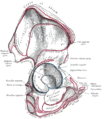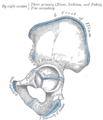|
Ischial tuberosity
The ischial tuberosity (or tuberosity of the ischium, tuber ischiadicum), also known colloquially as the sit bones or sitz bones,[1] or as a pair the sitting bones,[2] is a large posterior bony protuberance on the superior ramus of the ischium. It marks the lateral boundary of the pelvic outlet. When sitting, the weight is frequently placed upon the ischial tuberosity.[3] The gluteus maximus provides cover in the upright posture, but leaves it free in the seated position.[4] The distance between a cyclist's ischial tuberosities is one of the factors in the choice of a bicycle saddle. DivisionsThe tuberosity is divided into two portions: a lower, rough, somewhat triangular part, and an upper, smooth, quadrilateral portion.
Additional images
See alsoNotes
References
External links
|
||||||||||||||||||







